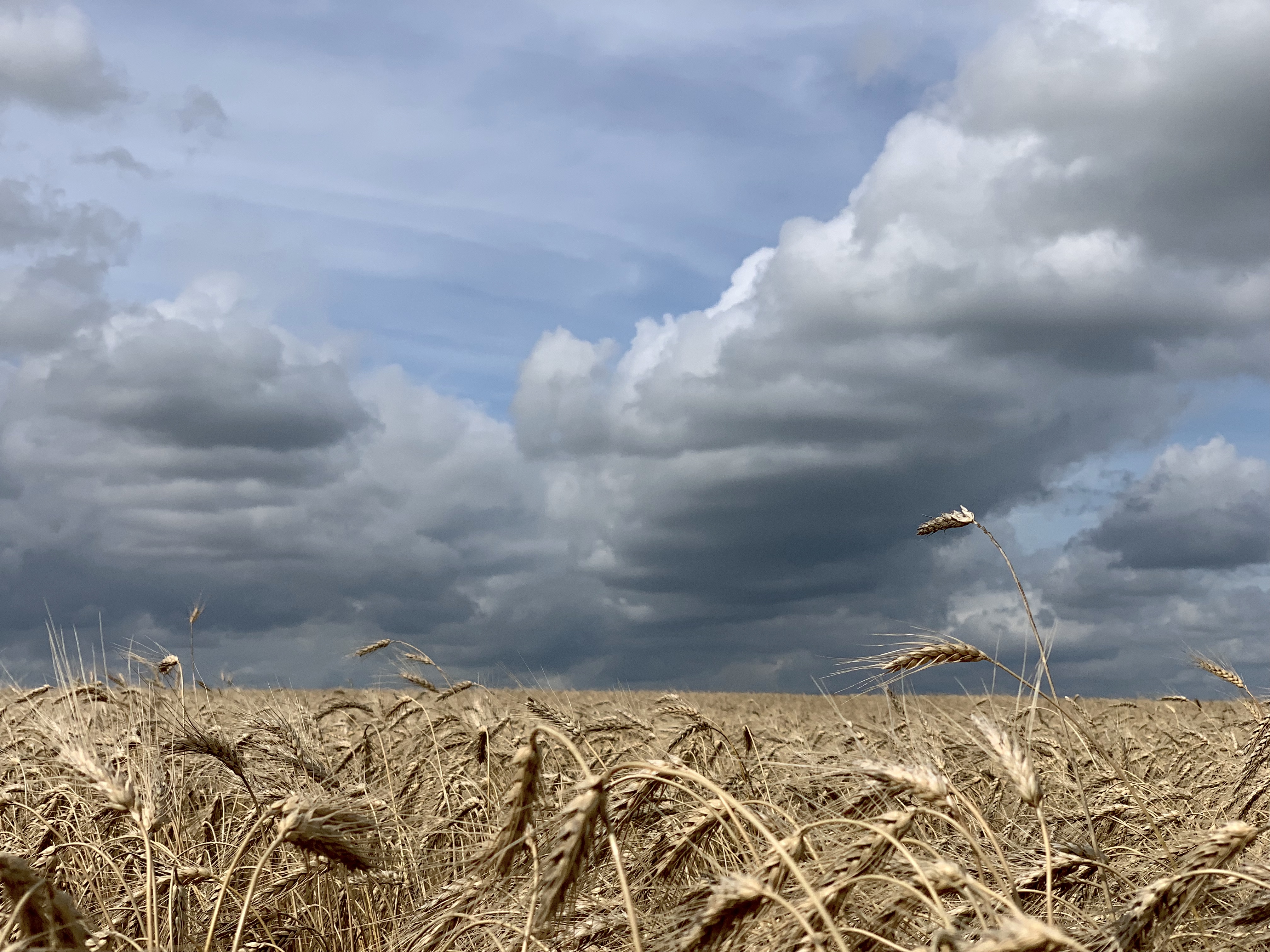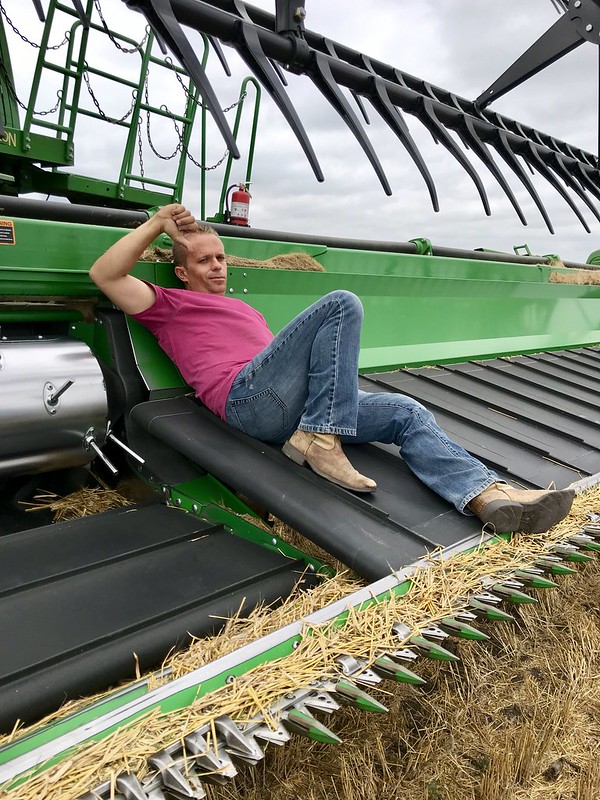
28 Aug Brian: A soggy South Dakota saga
Onida, South Dakota – I feel I’m beginning to sound like a broken record. Since we have arrived here, harvest has been plagued by cool weather and wet conditions not seen for decades. As we cross the one-month mark since our arrival, no one could have anticipated so few acres would be harvested up to this point. I wish I had better news to share, maybe something a little more cheery to talk about. That’s not the case this time, and I guess there is no reason to sugar-coat our mood. Farmers and harvesters alike are feeling discouraged, depressed and down … but not out! Slow and steady wins the harvest race some seasons, so we continue to work short days between rain showers. Watch the video below and I’ll tell you more in depth how harvest has progressed since we last got together.
Storm clouds appear once again as the combines race to get get every acres we can before another rain delay hauls the operation. The wheat fields here are so large sometimes they meet the horizon, seeming never ending. Square mile fields are the norm, not the exception here.
South Dakota has not seen rainfall amounts like this in quite some time. Ditches, ponds and lakes have overflowed recently, and numerous roads have been closed (at least temporarily) due to flooding. A major gravel road used to haul grain by nearly everyone here had to be closed, causing time-wasting detours and extra hauling miles. This is highly unusual.
The winter wheat was already somewhat tangled and down when we arrived, an indicator of the high yields farmers were excited to see. Mother Nature cruelly stole some of that yield. Kernels lie on the ground, shaken loose by hail. Wheat heads now lay on the ground, beaten down by high winds and pounding rains. Despite the draper headers harvesting two inches above the ground, some of the grain can not be retrieved. Come walk around in the wheat with me and I’ll show you first hand in the video below.
Wind-blow, broken straw plagues every winter wheat field left standing in this area. Heads hang low, some touching the ground just out of reach of the combines. Sprout damage, low test weight, and disease damage causes the grain to be graded poorly and docked at the elevators. The promise of a bountiful harvest has turned into a disappointing loss of profits for many.
We harvested this field weeks ago after it sustained sever hail damage. Wheat kernels that should have been in the grain big were lost from the storm, now sprouting and forming a green carpet across the fields. t’s a common sight in the area, and a somber reminder of the devastation the weather left behind in a matter of minutes.
The muddy ground has become almost more of a concern than the wheat moisture, forcing us to go around standing water and limiting truck access to many fields. Sometimes even turning a truck around on solid footing has proven challenging. A little rain never hurt anyone, so I braved the elements to show you a few of the challenges in the video below.
Muddy tracks in the field entrance show just how challenging the rain has made it for the trucks. Fields are being harvested in a specific order based on the ability of the trucks to even access the combines and park safely off the road. It’s a headache no one wants or needs.
With such large fields, “truck trails” on section line roads are often the only way to access the combines to haul out the grain. As you can see, many of these paths will not be usable for the rest of harvest. This means the combines sometimes have to drive out to the trucks, wasting precious harvest time and causing plenty of frustration.
It really is true, we have yet to put in a full harvesting day in the past month. Only a handful of times have we started before noon, and one evening it was so damp we had to shut the machines down before 6 p.m. Some days have only allowed 2 to 4 hours of work. Just as the wheat is ready to finally go again, or the mud has dried up enough to harvest, another rain event brings the show to a halt.
Boredom sets in as we spend many afternoons in the field waiting for the wheat to dry down. Brian finds his combine equipped with many comfort features, but it still lacks a comfy reclining chair to take a nap in, so he improvises. His enthusiasm appears to be lacking.
Apparently even the boys find waiting in the field repeatedly a little dull. Ezra attempts to elicit a few laughs with a novel demonstration of how to wear your hat and sunglasses. A new fashion trend soon to be picked up on the harvest trail? Maybe, maybe not.
How about some good news? Slow progress is still progress, and I’m happy to report we have finished all our winter wheat acres. We never could have anticipated it would take nearly a month, but we are ready to move into better harvesting conditions. The spring wheat that survived the hail is standing tall, meaning for the first time we don’t have to harvest on the ground. The machines have less straw to process, meaning harvesting speeds are virtually doubled. Most of the spring wheat is now ripe, and we just need some heat and sun to get back in the field. Seriously, I could not make this up if I tried, but we are currently on another rain delay. Highs this week are forecast to be in the 60s with lows in the 40s, so it’s not the weather we likely want. Still, harvesting progress through the spring wheat should be at a drastically faster pace.
South Dakota offers a view we don’t see in southern states—beautiful sunflower fields. Sometimes we finish harvest here before the sunflowers bloom. This year they seem to be trying to lift our spirits with their cheery display of yellow.
The men may not be working in the field, but that doesn’t mean laundry stops being created. The rain also doesn’t stop the need for meal preparation. Brenda and Vernelle work every day, even when the guys might enjoy extra down time. Cooking two meals also is extra work when rainy weather means lunchpails with cold sandwiches are not on the menu. Everyone is appreciative of their hard work “behind the scenes” to keep the show on the road.
We have been preparing for the inevitable for a while now, and that’s the challenge of school starting back home before harvest wraps up. We were hoping it might all come together at the last minute, but the difficult decision was finally made. Brenda would return home with the four boys so they would not miss those first few critical days in school. Vernelle works in the school kitchen, but arrangements were made for her to be gone from work so she could continue the meal and laundry service while the men are in the field and to help move equipment back home once harvest wraps up. It’s incredibly difficult to pack up and leave Cameron and the rest of the crew behind, but Brenda successfully made the solo trip back to Iowa with the boys. So now we are adjusting to our new normals being apart after 10 weeks together.

Titus and Ezra take one last combine ride before they return back to Iowa for school. With four young boys no longer around it seems a little quiet around here. They are sad to see summer over, but are eager to rediscover their toys back home and see friends again.
Brenda pulls if off again, successfully packing up a summer of belongings into the pickup, driving four smiling faces 500 plus miles home and “restarting” normal life back at home in Iowa as a single parent temporarily. Everyone is glad every year does not requires the additional stress of returning home at different times.
Every year is different, but no one expected South Dakota harvest to turn into a soggy saga. With the decision to not move to North Dakota this year our harvest run is coming to an unusual conclusion. Sometimes it seems wheat harvest may never end and then the inevitable finish draws near. The end is in sight, but I’m not sure I’m mentally prepared for it to be over yet. Until then, every acre suddenly takes on a new meaning, a different appreciation. You’ve tagged along all summer, so be sure to not miss out being a part of the final chapter.
The storms have definitely caused setbacks and losses this year, but farmers are still focusing on the big picture—a bountiful harvest. Many outdoor storage piles have been needed because of the big yields, and the golden pyramids of wheat are a constant reminder to be thankful for what the Lord has provided this year, despite the weather woes.
All Aboard Wheat Harvest is sponsored by High Plains Journal and John Deere. Be sure to join the conversation by leaving a question or comment. Brian can be reached at Brian@allaboardharvest.com.













Sorry, the comment form is closed at this time.